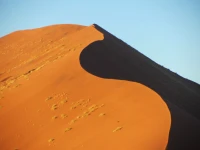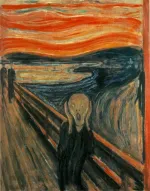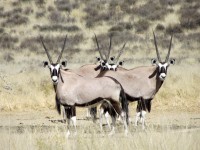This post is part of Kalahari Series II – 2011. The previous post in the series is The Long Road North – Upington to Twee Rivieren and beyond. Also see Kalahari Series I – 2009.
Our 2011 trip to the Kalahari was a little different to our previous trips. We found out after we had booked, that a group of friends were also going to be there in August, and that we would all be in the same camps for three days. This meant being able to do game drives together – a bonus as two of the other group are exceptionally sharp-eyed and good at spotting game. We also got together for evening meals and were then able to talk about what we had seen that day.

The Grootkolk camp with the communal fireplace (©2008 WMB)
Our last evening in the same camp was at the Grootkolk camp – a beautiful, unfenced wilderness camp (see this post about Grootkolk). That evening we all got together for a braai (barbecue) at the big communal fire-place, and watched the sun go down. After dinner our friend Piet told us he was going to read us a story. I thought that it was going to be one of the typical, funny stories that rural storytellers like to share. What he read to us though was totally unexpected and shocking. It was the story of Grootkolk and what happened there many years ago.

Sunset at Grootkolk. ©LB/notesfromafrica.wordpress.com
To look at Grootkolk today – a small camp of four 2-person units and the camp guard’s house next to a water hole – one would think that is how it has always been. I had never thought that modern-day people lived in the area which is now the Kgalagadi Transfrontier Park. Or that its history is so colourful and brutal.
When Piet started his story, he asked who among the group spoke German. I wondered where he was going with this, and soon found out. Piet is a good storyteller and was able to weave a story through a combination of telling the story, and reading a couple of well-chosen pieces from an old out-of-print book he had brought along. The book is called “To The River’s End” by Lawrence G. Green and was first published in 1948.
To retell the story, I’m going to quote the same pieces which Piet read to us . . .

The Grootkolk water hole no longer looks like this. There is less water and less bush immediately around it – and definitely none of the “reeds” which the author writes about. Image from “To The River’s End” By Lawrence G. Green.
Our camp is fifteen miles from Union’s End. It is etched weirdly on the screen of memory because of something which happened the second time I camped there.
Nowadays they call it Grootkolk – the few who know it. A “kolk,” of course, is a hollow in the ground which stores up water in times of rain or flood. Some water-holes are named after men who drank there long ago, for water in the Kalahari is important and memorable. This spot is simply the “Large Hollow” in the dry bed of the Nossob.
At first glance Grootkolk does not seem in any way weird. Kameeldoorn trees shade the camping spot, and though the water hollow is not much larger than a bath-tub, fringed by reeds and bushes, it is such a rare sight that it gives the whole place an air of security. Before the Union Government sank bore-holes at Union’s End and elsewhere, this was the only water in a vast area.
Knowing nothing of Grootkolk, you might have seen our camp merely as a typical Kalahari outspan. Strings of biltong, springbok and jackal skins hung up between the trees. A leather overcoat flapping in a cold breeze. Bandoliers on branches and rifles resting against tree-trunks. Blankets airing on another tree. Canvas water-bags and field-glasses dangling from other branches. Boards on petrol cases forming a table littered with brandy bottles and pickle jars.
You would have seen hunting knives and shot-gun cases, sacks of flour and sugar, tin mugs and tin plates, and a haunch of royal game on a tree-stump. The white ash of a fire that burnt well, without much smoke. A car, a van and a truck, on the first expedition, and about a dozen men sitting round on biscuit-tins.
But if you had prowled round Grootkolk searching for signs of older occupation, you would have found them. Rusty ration tins, stamped with German words. Empty cartridge cases. Large water-tanks with holes drilled in them. Steps made from horse-shoes hammered into the trunk of the highest kameeldoorn. Lengths of field telephone wire. And finally, a relic such as only a bored soldier would leave – a flattened ration tin with the one word GEINAB punched out with a nail and fastened to a tree.
Geinab was the old Hottentot name of Grootkolk. “Tinky” Craill, our desert guide on the first trip, had never heard the name. Geinab was before his time. But in the days when the Germans were at war with the Hottentots, this place was Geinab.

Image from “To The River’s End” By Lawrence G. Green.
And then the writer himself starts telling a story of what happened at Grootkolk many years before that. Of the largely forgotten conflict between the Germans from what was then German South West Africa (now known as Namibia) and the “Hottentots” i.e. the rebellion of the Nama people against German rule (various uprisings occurred during a 15-year period between 1893 and 1908) in the then German South West Africa. Grootkolk lies very close to the Namibian border.
And so the tale continues . . .
The mood at Grootkolk that night was not sombre, but certainly it was reflective. Last time we had camped here far several days. Now one night would be enough; we would drive on far into the north and turn only when we reached Angola. Life had changed and I had changed, too. In these two years Grootkolk had become a different place.
Different, that is to say from the Grootkolk of the first visit. To my way of thinking, Grootkolk had become Geinab. Outwardly it was exactly the same. But very often you see a place through the eyes of your companions. The crowd of the first expedition had gone. Tonight three of us were sitting in an old German outpost . . .
. . . There was no mystery about Geinab, but it was a ghastly affair. Nevertheless, we sat round our fire at Geinab and I told them all I knew, and spared them nothing.
At the end of a long and fierce campaign the last of the Hottentot bands were still fighting it out with the German patrols in the Kalahari.
It had started in 1904, with a formal declaration of war by the old Hottentot “Kaptein,” Hendrik Witbooi. The Hottentots were cunning, the Germans ruthless whenever they were able to take their revenge. One by one the Hottentot leaders surrendered or were killed … Witbooi himself, Marengo and Morris. Only one remained, a bold and cunning leader named Simon Cooper. Driven eastwards into the dune country, Cooper fought on desperately and skilfully.
Captain Freidrich von Erskert, in charge of operations against Cooper, was killed. The guerrilla war dragged on for nearly three years. Cooper had the sympathy of many queer characters on the British side of the border. Gun-running flourished along the lawless frontier.
Finally the Germans placed small garrisons at every waterhole, and sat down patiently to wait for Simon Cooper and his men to die of thirst. Geinab was one of these outposts. The frontier with the Cape Colony had not at that time been clearly marked; the metal plates bearing the British and German coats-of-arms, erected at frequent intervals, came later. So it happened that the garrison at Geinab was about sixteen miles inside British territory. Geinab was so far from anywhere that no one knew it, or bothered about the little desert war that was being fought on the sands of the Cape Colony.
A Tsamma melon – loved by people, animals and birds for the moisture they provide. ©LB/notesfromafrica.wordpress.com
Simon Cooper did not die of thirst. He and his men lived on the t’samma melon, the wild melon which yields purer water than the “kolk” at Geinab. They drank heartily, and then scouted round Geinab and planned an attack. Cooper decided that it would be useless to aim at the German camp in the ordinary way, for the Germans had their trenches and no seasoned soldier would expose himself once the first shot had been fired. So one night Cooper put his snipers into the high kameeldoorns. No Hottentot ever wastes a shot, and when Cooper’s men opened fire at close range at daybreak the German soldiers started falling.
It was a hopeless position. The surviving Germans jumped on their horses and headed west. This was exactly what Cooper knew they would do. Cooper’s mounted men barred the path and captured the survivors. They were led back to Geinab. I have no sympathy with the Germans and their “wars of extermination” in South-West Africa; but I pitied those doomed soldiers at Geinab. They should never have surrendered.
Cooper’s men stripped them of their uniforms, then told them to march back naked to their own country. The Germans marched. One can imagine them looking back over their shoulders.
As they marched, the Hottentots shot them down. No doubt some of the Germans ran, making better sport for the Hottentots. It was a war in which no quarter was given, and the survivors of the Geinab garrison were shot in the back to the last man.
Quite a story . . . It certainly made me think of this place, which I thought I knew so well, in a completely different light. With that story in our heads, we went to bed to the sounds of jackals and hyenas close to the camp. The animals now rule at The Last Outpost.

Waterhole at Grootkolk as it looks today. (©2009 WMB)
The extracts in this post come from “To The River’s End” By Lawrence G. Green. Thank you to Piet van Zyl for telling the story at Grootkolk, and for the loan of his copy of the book.
The Kalahari 2011 Series:
- An oasis in the desert
- Take your camera to the bathroom (and other Kalahari safari tips)
- The Long Road North – Southern Cape to Upington
- The Long Road North – Upington
- Showing your kid where its food comes from
- Fierce Creatures
- Gemsbok Graphics
- The Long Road North – Upington to Twee Rivieren and beyond
- Campfire story: The Last Outpost (this post)
- Slip-Slap-Slop-Slide and other Bush Beauty Tips
- Nossob
- Hey Mom . . . wait for me!
- A tough customer
- Frenzy at the “water hole” – includes the movie
- The Camp Cat




















Wow. What a story. Thanks for sharing it with us. We also have a history – just not always known to us.
Yes, quite a harrowing story to hear as a bedtime story! Especially travelling through a place like the Karoo, one doesn’t imagine that there have been people living there before. But as you say, every place has a history. Lawrence G. Green wrote many books about various places in South Africa, telling all the old stories.
Wow, is right! What an amazing story–the telling of which is so compelling! Don’t you love learning the story behind a place–a narrative that makes it what it is and isn’t?
Thanks for sharing this, Lisa!
Kathy
I though it so interesting that Piet was telling/reading us a story, and in it the author is also telling a story to his camp-mates at the same place.
I particularly like the passage “But very often you see a place through the eyes of your companions. The crowd of the first expedition had gone. Tonight three of us were sitting in an old German outpost . . .”. Which is so true. Willie and I had always been there on our own (with strangers in the other cabins), never in a group like this. It made the experience very different for us too.
Fascinating place, your Kalahari. Very sobering and rare story…makes me shudder a bit.
Thanks for reading and commenting on this post. I know it’s not an easy one to stomach. Grootkolk is so beautiful and peaceful – I never imagined it had such a violent past.
What an amazing story!
Yes, and quite an alarming one to listen to at night in the bush!
That I can believe.
I can imagine sitting there, with the crackle of the camp fire, listening to this haunting story… Amazing story – thoroughly enjoyed it.
I normally have trouble “feeling” history in South Africa (as opposed to Scotland, where it seeps into my soul with every step I take). Goes to show that there is so much more to a place than we can ever know.
Thanks for sharing this 🙂
Obviously Scottish history goes back much further, and you get a sense of it because of all the old ruins etc. But there are some interesting South African stories too. I’ll probably feature some more “campfire stories” about the Northern Cape and Kalahari. Although nothing as dramatic as this one.
Truly a well-told story, Lisa – love the detailed descriptions.
My ancestors came over from Germany to what was then German South West Africa, at the turn of the last century (1900 or thereabouts). Even though none fought in the deep south, as far as I know, the sense of historical connection to that land is still very strong inside me, so this definitely added another dimension for me.
Thank you so much for sharing this. I’m sure there must be many more such places in the seemingly open veld and apparently barren desert, each with a story to tell.
Thank you for reading it. This was terrible story – albeit a well-told one. People can be so ruthless with each other – especially during war time. I agree with Lawrence Green when he says “I have no sympathy with the Germans and their “wars of extermination” in South-West Africa; but I pitied those doomed soldiers at Geinab. They should never have surrendered.”
There are a couple more of the Northern Cape/Kalahari stories to tell, though thankfully nothing as bad as this one.
Love the story-telling aspect to this post. Fabulous!
Glad to hear that you liked the post. I want to do a couple more of these “campfire stories” – although less tragic ones.
That’s a fascinating history, although perhaps not one I would want to hear right before bedtime!
It’s quite a story isn’t it? Made even more scary by the fact that we heard it at night around a campfire. Thanks for reading it and leaving a comment.
MY FATHER WAS COMMISSIONER OF POLICE IN THE UPINTON -KALAHARI DISTRICT AND WROTE ABOUT IT[THIS WAS BEFORE 1940] . I AM PRESENTLY RETYPING WHAT HE WROTE.,HE WRITES ABOUT TINKIE CRAILL- WHO AS A GOOD FRIEND OF HIS ALTHOUGH HE HUNTED ILEGALLY AND TELLS SOME HUMOROUS THINGS ABOUT TINKIE. IT’S FASCINATING THAT THE CRAILLS ARE STILL THERE.
Hi Laetitia! Thanks for visiting my blog and leaving a comment! 🙂 It’s so interesting that your family has a connection to the Kalahari. Are you going to publish your father’s writings anywhere? I would love to read more about this area.